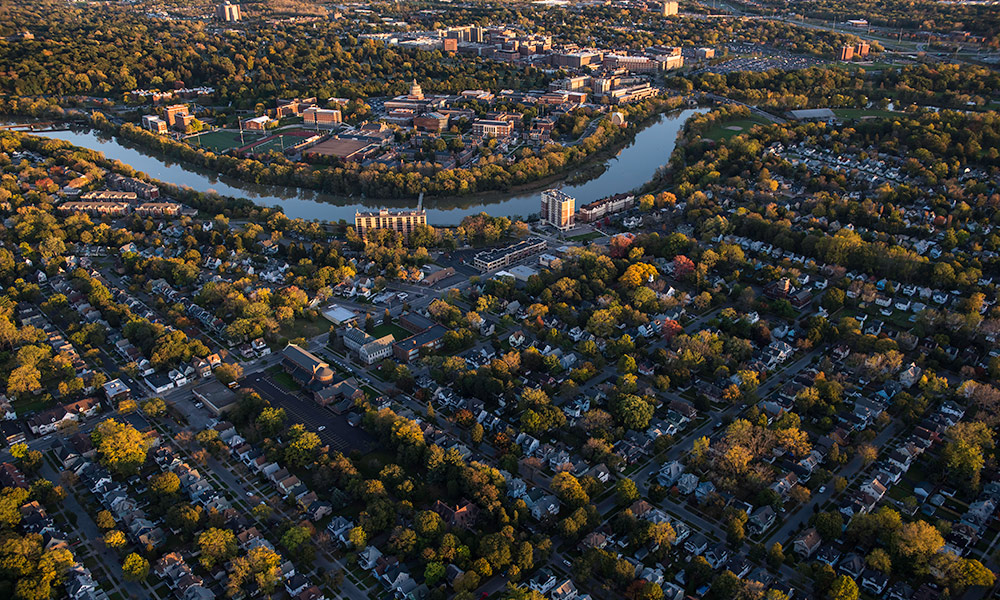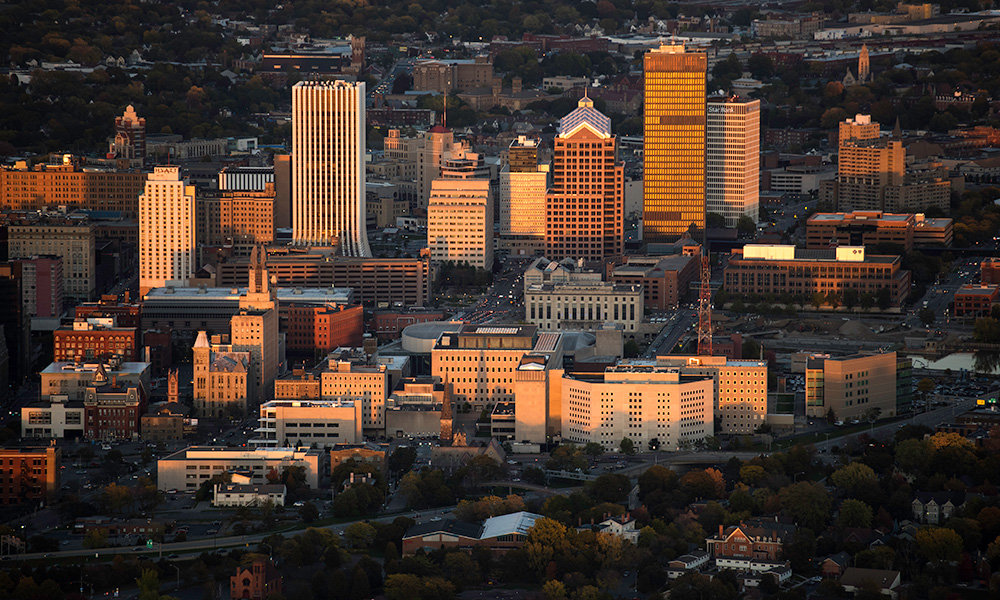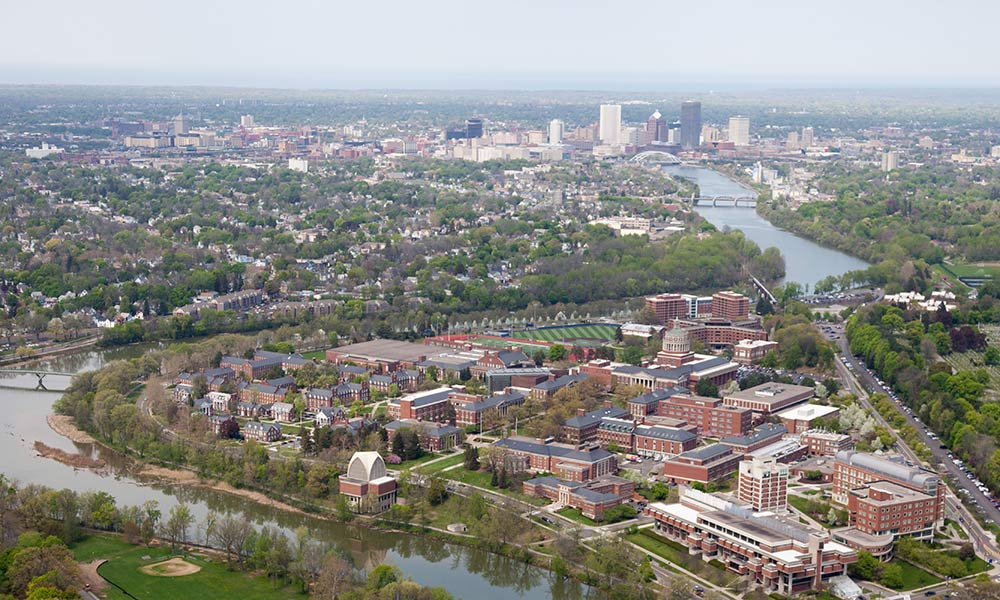Latest analysis highlights the University’s role as a ‘critical engine’ whose economic impact has grown during the past decade and a half.
A new report by the Center for Governmental Research (CGR) reveals that the University of Rochester has more than doubled its impact on the region’s economy in the last 14 years.
The analysis, based on 2019 information, also shows that the University is the largest private employer based in upstate New York and the seventh largest private employer in the state.
“The growth in the University’s scientific, education, and health care missions, fueled by public support and philanthropy, generates a significant impact on the region’s economy in the form of innovation, entrepreneurship, and employment,” said Sarah Mangelsdorf, president of the University of Rochester. “At the same time, we recognize that the University has a broader responsibility to improve the lives and health of our community members and to work with community partners to revitalize the City of Rochester and build bridges to economic opportunity.”
Latest in a series to assess the University’s economic impact
The report is the eighth in a series of biennial assessments by CGR of the employment and payroll, capital expenditures, purchasing, student and visitor spending, and tax impact of the University of Rochester, UR Medicine, and its affiliates.
UR Medicine affiliates include Highland Hospital, F.F. Thompson, Noyes Health, St. James Hospital, and Jones Memorial Hospital, and many of those institutions are the largest employers in their respective communities.
The CGR analysis finds that the job impact of the University—both in terms of direct employment and spillover effect—has more than doubled since CGR started compiling the reports in 2006 and sustains a total of nearly 68,000 jobs in the New York State economy.
Other findings in the CGR report include:
- In 2019, the University had 32,408 employees (28,261 full-time equivalents), a growth of 5 percent since 2017;
- The University paid $2.2 billion in wages in 2019, and was responsible for $4.7 billion in direct and spillover income;
- Over the last five years, the University has averaged about $324 million annually in capital investment spending, providing steady employment to the region’s construction industry;
- Spending and employment contributed $300 million in sales, income, and property taxes in 2019;
- The University attracts an average of $425 million in external research funding per year;
- The University purchased goods and services totaling approximately $1.3 billion in 2019.
Economic impact of new initiatives
The report also assesses the impact of several new University initiatives.
The University’s Laboratory for Laser Energetics has proposed building a next-generation laser user facility dedicated to the study of ultrahigh intensity laser-matter interactions. CGR estimates the $145 million project, called EP-OPAL, will create 250 to 270 new jobs and increase annual research funding by $10 to $12 million.
A new $227 million UR Medicine Ambulatory Orthopedics & Physical Performance Center at Marketplace Mall, the largest off-campus capital project in the University’s history, will create almost 1,000 construction jobs.
And the Wilmot Cancer Institute’s campaign to regain National Cancer Institute designation will not only help reduce the significant burden of cancer on our region, but also generate growth in research and clinical activities that are estimated to create 1,900 jobs.
“The University’s economic significance cannot be captured by the simple sum of jobs and payroll,” said Kent Gardner, principal and chief economist for CGR. “Through its diversity of employment opportunities—from direct patient care at Golisano Children’s Hospital through cutting-edge research at the Wilmot Cancer Center or Laboratory for Laser Energetics—the University offers a career ladder for residents and a reason for global talent to relocate to Rochester. As the center of Rochester’s cultural life, it also supports the retention of our most talented residents, a key element of community stability.”
“The University of Rochester serves as a critical engine to drive business growth throughout the Greater Rochester, New York, region, providing world-class R&D assets and well-trained students to fuel the community’s talent pipeline,” said Matt Hurlbutt, president and CEO of Greater Rochester Enterprise. “We value the University of Rochester’s partnership and investment in Greater Rochester Enterprise’s initiatives to foster the growth of the regional economy.”
The report includes a list compiled by CGR of the state’s largest private employers. The University of Rochester, UR Medicine, and its affiliates were ranked the seventh largest in the state, and the largest upstate-based employer. Six of the top 10 highest ranked private employers are universities with academic medical centers or health systems.
Read more
 New report details growth of University of Rochester
New report details growth of University of Rochester The University of Rochester has added 9,000 employees over the decade since 2006.
 Understanding the University’s economic impact
Understanding the University’s economic impactMore than an institution of higher education, the University of Rochester is an economic engine for the nine-county region and beyond.
 University’s economic impact expands across New York State
University’s economic impact expands across New York StateThe University of Rochester’s economic impact is growing both in size and in reach according to a new report.


